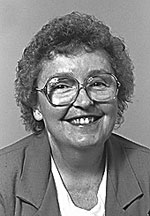Cornucopia / Cynthia Dewes
Native American missions still serve the pagan babies
 Remember the pagan babies? Most Catholic school students now over the age of 40 can’t help but remember them.
Remember the pagan babies? Most Catholic school students now over the age of 40 can’t help but remember them.
They were the face of the missions for most of us, the poor unfortunates who not only lived in poverty, but also in ignorance about the existence of God and human salvation through God’s Son.
It was the vocation of the missionaries in the Church to remedy this.
So every year, usually at Christmas and Easter, there were school campaigns for money that the missionaries needed to deliver the pagan babies from squalor and spiritual deprivation. I am not sure how much cash this brought in, but at least it made us aware of the need. And it illustrated the word “charity” for the children.
Believing that charity begins at home, our family for many years helped support two Jesuit missions in the western U.S.
One is St. Stephens Mission on the Wind River Indian Reservation in Wyoming, where Indiana’s native son, Bishop Paul Etienne, now presides. The other is St. Francis Mission on the Rosebud Indian Reservation in South Dakota. Recently, we visited both missions for the first time.
St. Stephens serves the Arapaho and Shoshone Indians in the beautiful Wind River Mountains. It features a large school, and also offers outreach programs for job training, often in the use of native crafts, as well as support services for the parishioners’ basic needs.
Four times a year, they produce a wonderful publication called The Wind River Rendezvous, which contains photographs and stories of the local culture, geography and history. They also profile the priests, religious and laypeople who have served the mission, and describe the flowering of the mission’s expansion, both physically and spiritually.
On the mission grounds today stands the former Indian school, a large building typical of mission school architecture at the time it was built. Now it is used for administrative and social activities. A large, modern school nearby is styled to carry out the Indian decor.
But the main attraction is St. Stephens Church, an old-fashioned, square building with a large steeple on top. Local Indian artists have decorated it inside and out to incorporate and reflect aspects of the Native American religion. The altar looks like a large ceremonial drum in front of a
teepee-like structure framing the back wall. Stained-glass windows depict Indian saints or motifs, and the result is reverent and beautiful.
St. Francis Mission in South Dakota serves the Lakota Sioux population. It provides drug and alcohol addiction counseling, treatment and rehabilitation, including Betty Ford Center programs, because drug and alcohol abuse create many problems on the Rosebud Reservation. Several buildings are devoted to this work, and a new school is also under way.
The historic lavender-colored stucco church is large, with a beautiful, traditional interior. Jesuit Father John Hatcher, the president of the mission, showed it to us and celebrated Mass while we were there. He also took us to their gift shop and museum, filled with Indian artifacts, costumes and historic objects to complement the handmade jewelry and other lovely crafts for sale by local artisans.
Our tours of the two missions impressed us with the strong faith so evident among the Jesuits and laypeople who have labored there for more than a century.
The missions are humble places, striving every day to share God’s joy and dignity with the Native American people they serve. The pagan babies are still in good hands.
(Cynthia Dewes, a member of St. Paul the Apostle Parish in Greencastle, is a regular columnist for The Criterion.) †
 Remember the pagan babies? Most Catholic school students now over the age of 40 can’t help but remember them.
Remember the pagan babies? Most Catholic school students now over the age of 40 can’t help but remember them.